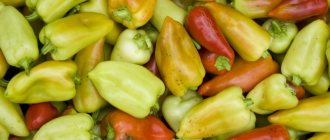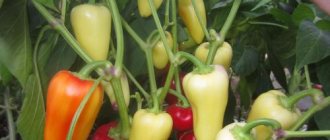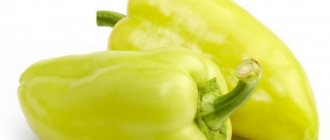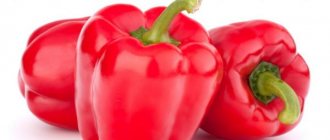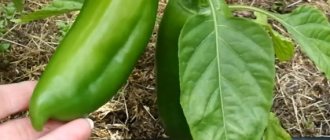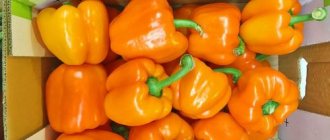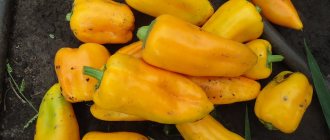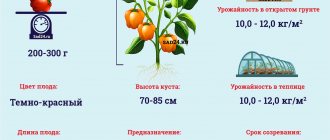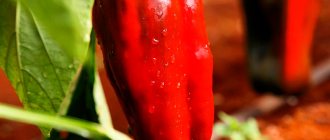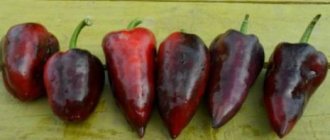16 reviews for the product Sweet pepper Golden Pheasant
Write a review
I am not sure
I grew the pepper and it’s not bad, one thing worries me: it’s not the same shape as in the description and in the picture. A doubt creeps in that the seeds in the bag are of the wrong variety.
befits
I love thick peppers, it’s good that the store has a great selection of them, I’m really pleased with the growing variety of Pomodorchik, this variety and another Gourmet variety.
miracle pepper
I picked up a miracle pepper of this variety at the Pomodorchik store. There is a growing variety of dekilka rocks and I am already producing the same varieties. I hope that the number of customers in the store will increase, and the choice here is even greater.
I bought the variety on the advice of the store
I can’t blame the store for poor service, because my question was resolved very quickly, although I thought I would wait half a week for an answer. They give some good advice for beginning gardeners, so listen and don’t be afraid to ask.
liked the variety
I used to buy seedlings from the market and was almost never satisfied with them. After all, I was buying a “pig in a poke.” They say that seedlings of thick-walled peppers grow into regular, thin-walled ones. Once I started buying seeds and growing seedlings myself, this problem resolved itself.
has already risen
As you know, pepper seeds are sown for seedlings in early February - that’s what I did. The seeds sprouted perfectly, I’m waiting for them to grow and dive
I recommend the variety
Last summer, this variety was very productive, although there were no large peppers, mostly medium-sized, but I don’t need large ones, my wife stuffs it and the medium one is just fine.
I liked the variety, I grew it for the first time. I read a lot of information about each type of pepper. I settled on this variety.
The variety is excellent, I grew it last year and the harvest was normal. I included these seeds in my order this year too. All in hopes of planting this spring.
Errors in agricultural technology
It's hard to rise. I blame myself for trying to grow it directly in open ground; I should have planted it as seedlings. I'll try again in 2016.
The taste of the Golden Pheasant peppers I grew is excellent. I’m very pleased that I chose this particular variety, I wasn’t mistaken.
wonderful variety
I don’t know about anyone, but I prefer yellow varieties of peppers. I have been growing Golden Pheasant for several years now. I like it both in taste and because it lasts a long time in the refrigerator, it’s a very tasty pepper.
Good seed germination
Last year I bought these seeds for the first time in Pomodorchik and decided to sow them not in a greenhouse, but in a greenhouse. I took a large bathtub, filled it with soil and sowed the seeds, and covered it with glass on top. Because of this, the temperature inside was quite high and the seeds sprouted very quickly, and the seedlings grew too.
Nothing special
I should note that I am still a sincere fan of yellow peppers. However, I can’t say that this variety captivated me completely. Regardless of germination, I was not impressed with the taste of this variety.
This variety is recommended
I can't find a way to get pepper. I'm not a professional and I often make mistakes when growing vegetables.
A relative recommended “Golden Pheasant” to me; she says that yellow peppers are the best. Today I ordered seeds, I hope that “Malachite Podolia”, unlike market seeds, will not let you down and the pepper will be juicy and not sluggish.
Golden miracle
Sweet pepper “Golden Pheasant” is best grown where there is enough moisture or it must be watered constantly, otherwise it begins to lose its juiciness and simply withers on the stem.
The varieties of peppers, both sweet and hot, are striking in their diversity. Domestic gardeners are sometimes even lost at how interesting and original the fruits of this crop can be. At the same time, along with yield indicators, many take into account other characteristics of varieties, for example, the location of fruits on the branches.
Among the popular types of peppers are those whose fruits - cones, prisms or balls - grow upwards rather than downwards. In this review we will tell you about sweet and hot varieties with unusual, upward-pointing fruits.
Ultra-early varieties of thick-walled peppers
For cultivation on ridges in most Russian regions, it is advisable to choose an early ripening crop. Such varieties manage to form fruits in a short summer period and achieve the declared characteristics before the onset of cold nights. Super-early varieties have been developed that have proven themselves successfully in temperate climates.
Find out here how to prepare pepper seeds.
Tamara F1
An unpretentious Dutch hybrid with dense peppers. Pericarp – 7-8 mm. The sweet pulp is juicy and has a pleasant aroma. When mature, the color is bright red.
Khalif F1
When ripe, the elongated “cubes” of the hybrid have a rich orange-red color. The peppers are juicy, with thick (9 mm) walls and thin skin. The sweet taste of the hybrid of Japanese selection, lack of bitterness, and juiciness are noted. The fruits weigh about 180-210 grams.
Sonata F1
The hybrid has shown itself well in regions of risky farming.
Tasty, thick-walled (6-8 mm), meaty. Unripe prism-shaped fruits are green, fully ripe ones are purple-red.
Quickley F1
A minimum of care is required for this productive hybrid. On ridges it yields 4-5 kg per square meter. The fruits are in the form of cones, at first a delicate salad color, then the color changes, the skin becomes dark red. Wall thickness – 7-8 mm. The hybrid is resistant to most diseases.
Zarya F1
Three months pass from germination to harvesting of hybrid peppers in a state of technical maturity. Forms fleshy cone-shaped fruits, walls – 8 mm, weight – 120-130 g.
On a note! The hybrid is characterized by increased transportability.
Samander F1
Low-growing hybrid of Dutch selection, very early. On ridges the bush does not need staking. High foliage. Sets peppers in any conditions (up to 18-20 pieces per bush). The “cones” are bright green at first and turn dark red as they ripen. The thickness of the pericarp is 6-7 mm.
Conditions for growing sweet peppers in open ground
From the moment the first shoots appear in pepper crops until the fruits ripen, a fairly long period passes: on average, 110-125 days. Provided that all this time the temperature should be about +20 degrees, in some Russian regions summer residents understand that this is impossible. Such a long summer is found only in the south; moreover, the pepper crop is extremely demanding on the abundance of sunlight.
Important! The optimal temperature for growing sweet peppers is +26-30 degrees. Some varieties stop developing if it gets colder than +15 outside.
. However, there is a way out of the situation
The process of growing peppers is divided into three separate stages:
However, there is a way out of the situation. The process of growing peppers is divided into three separate stages:
- selection and sowing of seeds;
- growing seedlings at home;
- planting seedlings in open ground.
This method is called “seedling” and is appropriate both in central Russia and in the south. Now let's move directly to the varieties of sweet peppers with a thick wall.
Early varieties
Almost at the same time as the ultra-early ripening ones or a little later, they begin to harvest early ripening peppers.
Among the best thick-walled varieties and hybrid forms:
- Bagheera – large peppers up to 500 grams are formed on small bushes. When ripe, the color is first dark purple, almost black, then red. Pericarp thickness – 7-9 mm;
- Asti is a promising hybrid of Italian selection, beloved by summer residents. Cube fruits weigh 180-200 grams, pericarp up to 8 mm. Characterized by high productivity;
- Gemini F1 – productive, thick-walled (7-8 mm), tasty. Peppers are canary-colored, four-chambered. The hybrid is resistant to traditional diseases and grows well in areas with harsh climatic conditions;
- Golden pheasant - will surprise you with delicious golden fruits weighing 250-300 grams. Walls – 8-10 mm;
- Alyosha Popovich - on low bushes it will grow up to 10-12 fruits weighing 150 grams. Cone-shaped with walls 7-8 mm, they have excellent taste and aroma. The variety is resistant to verticillium. Suitable for preparing various culinary dishes, stuffing;
- Siberian bonus – presented. The variety is adapted to temperate climates and gives good harvesting results even in unfavorable weather. Since 2012 it has been included in the State Register catalogue. The plant contains 12-15 fruits in the shape of cubes, with a bright orange color when ripe. There is no bitterness in the pulp, the walls are 9-10 mm;
- Indalo F1 is a large-fruited, thick-walled hybrid. Thickness – 8-10 mm. The bushes are powerful, growing up to 1.2 meters on ridges. The plants are hung with amber-colored fruits, weight - 250-300 grams;
- Ozharowski is a Polish selection, the variety sets fruit even in low light. Among many varieties, it stands out for its piquant taste, the thickness of the amniotic pulp is 7-8 mm. The peel and pulp are burgundy in color, the fruit weighs 120 grams;
- Talion F1 is considered one of the largest-fruited hybrids with thick walls. Bred in Holland, shows good harvest in all regions of Russia. Grows up to 700-800 grams, walls – 10-13 mm. When ripe, it turns a rich burgundy color;
- Denis F1 is a hybrid of Dutch breeders popular among gardeners. Vegetables are harvested green after 85-90 days and become dark burgundy when fully ripe. It is little susceptible to disease; 8-10 fruits are collected from a bush (each weighing 400-500 grams).
Promising hybrids are Kerala F1, Aries F1, Latino F1.
Review of spicy varieties
Let's start with hot peppers, many of which are also grown as an ornamental crop.
Aladdin
Those who see this compact plant, strewn with colorful pods for the first time, do not even believe that it is a hot pepper.
This is exactly the Aladdin variety - beautiful, early, abundantly fruiting and, moreover, very pungent. It surprises not only with its high yield, but also with its magnificent, original appearance.
The bush grows up to 40-50 cm, so the variety is perfect for growing at home: either on a windowsill or on a balcony. The peppers are shaped like small cones, weigh about 20 grams, and grow upward. The color of the fruits is very unusual: at first they can be yellow, cream, pinkish, violet-blue, and only when fully ripe they acquire a red color. The taste of peppers is spicy, but they are very aromatic.
The variety is unpretentious, grows well even in shaded conditions, but still, to obtain a bountiful harvest, it is better to provide Aladdin bushes with light, warmth and moisture.
Falcon beak
The Falcon's Beak hot pepper variety is distinguished by its small size and compactness. Its fruits, directed upward and with pointed cones, truly resemble the beak of a formidable bird. The variety is mid-season, the first hot peppers can be harvested after 120-125 days, but until they are fully ripened, you need to wait about two more weeks.
The pods are elongated, up to 5 cm long, with a burning taste. Each of them weighs only 7-10 grams, but there are a lot of fruits on the bush. The variety is very well suited for drying; the fruits of Falcon's Beak are also used in various marinades.
Bride
The variety of hot pepper with such an original name will amaze with its abundant fruiting. On the bush, which grows only 30 cm in height, a large number of small, very fragrant pods are formed.
The variety is mid-season, grows well in greenhouses, and is also very often grown as an ornamental plant on the balcony or in the kitchen. The fruits are pods, grow upward, at first have a delicate cream color, then the skin becomes orange and then bright red. At one time, fruits of different colors can grow on the bush, and such a plant looks very elegant.
Fruiting is abundant and long lasting. The taste of the fruit is spicy, with a piquant spicy note.
Fire Volcano
For those who prefer unusual varieties, we recommend paying attention to the fiery Volcano pepper. During fruiting, the bush really looks very much like an erupting volcano, since its reddening fruits are directed upward. The variety is early, which is very suitable for gardeners in the northern regions. The first fruits are ready for harvest after 90 days; they can be picked green.
The pods are elongated, cone-shaped, reaching approximately 10 cm in length, weighing up to 15-19 grams. The walls are thin, up to one and a half millimeters, so this pepper is suitable for drying. The taste of peppercorns is hot and there is a specific aroma.
Queen of Spades
This variety of hot pepper is best grown at home or on the balcony, especially since it is very decorative. The bush has a round shape, its height is no more than thirty centimeters. The interesting fruits of the Queen of Spades are tiny cone-shaped peppers that are purple at first and then turn orange.
At the same time, there may be peppers of different colors on the bush, so during the fruiting period the plant looks like an exotic flower. This variety of peppers has a fiery taste and is very aromatic. They are used as a seasoning for soups, side dishes, and can also be added to marinades and preserves.
Constellation
This variety is characterized by extended fruiting, while the peppers ripen early. The bush is very low, well leafy. The fruits grow one at a time in the axil, directed upward. The shape of the peppers is similar to tiny hearts - pot-bellied, weighing no more than 9-10 grams.
It is no coincidence that the variety is named Constellation, since its fruits in different phases of ripening have different colors: purple, orange, yellow, bright lilac, red. It gives the impression of a real bright constellation – shimmering and multi-colored.
Peppers with thick walls for the middle zone
In the conditions of the Moscow region and nearby regions, early and mid-ripening varieties are cultivated on ridges. To obtain fruits with a thick pericarp, it is important to provide the plants with regular watering and good lighting.
| Name | Ripening time | Description of the plant | Description of fruits | Pericarp thickness | Peculiarities |
| Big mom | 90-100 days | Height – 70 cm, few leaves | “Cubes” up to 170-200 grams, orange when ripe. | 6-8 mm | They collect 6-7 kg per square meter. meters |
| Big Daddy | 96-105 days | They are distinguished by their small height and compactness. | Cone-shaped, first purple, then cherry-ruby. By weight – 80-120 grams | 5-7 mm | Blooms with blue flowers |
| Red Knight Ex F1 | 90-100 days | Medium height, high foliage. | Weighing up to 310-320 grams, cuboid. Stage of technical maturity – green, when ripe – red | 8-9 mm | High resistance to bacterial spot. |
| Novogoshary | 107-110 days | Low-growing variety, bushes up to 50 cm. | Round, slightly flattened. They weigh 80-150 grams. Very sweet. | 8-10 mm | Lezhky |
| Golden Jubilee | 111-114 days | Shrubs of low height (40-50 cm). | Slightly round, slightly flat peppers, 140-200 grams. Color – bright yellow. | 8.5-11 mm | It is distinguished by long-lasting harvest juices. |
| Turquoise | 118-120 days | Spreading bushes, up to 80-90 cm. Need a garter. | Cuboidal, dense-skinned fruits. Weigh up to 200 grams. The flesh is crispy and juicy. | 9-10 mm | Resistant to viral diseases. |
| The Golden Fleece | 105-110 days | Medium-sized plants, 70-90 cm. A large number of leaves on the bushes. | Cuboid, 180-200 grams. | 9-10 mm | |
| Antey | Mid-season, 120 days. | Tall powerful bushes, requires a large feeding area | 200-250 grams each. Ripe peppers are red in color. | 7-8 mm | Plant 5-6 bushes per 1 square meter. Resistant to verticillium. |
| Fat Baron | 90-100 days | Spreading bushes, 50-60 cm tall | Cone-shaped, 200-250 grams. Sweet, juicy. | 9-10 mm | Resistant to tobacco mosaic |
Landing
They begin sowing seeds for seedlings at the end of February or beginning of March, so that at the time of transferring the seedlings to a permanent place they are 60-70 days old.
A nutrient substrate is prepared for seedlings from equal parts of soil from the garden, sand and peat or humus. Mix every 10 kg of soil with 2 cups of wood ash and add a little mineral fertilizer according to the instructions. Then the soil is spilled with boiling water, a solution of potassium permanganate, or fried in an oven on a baking sheet to destroy fungi and parasite larvae.
Pepper adapts more easily to the site if you add soil from the very bed where you plan to plant it to the seedling substrate.
It is recommended to check seeding material for germination before planting. It is placed in a glass of salt water. Good seeds will sink in a few minutes, while empty ones will remain on the surface.
Then the grains are soaked in a 1% potassium permanganate solution for 15-30 minutes. You can replace it with a solution of Fitosporin. Then they are rinsed and germination is stimulated with Epin, Zircon or another stimulant.
The seeds are placed in grooves 0.5-1 cm deep, buried, carefully watered and placed under a film in a warm place with a temperature of +25-27 degrees. Open the cover daily for 15 minutes for ventilation. After germination, the crops are opened and transferred to the windowsill.
In the phase of 1-3 leaves, they are picked into separate containers. The seedlings are planted in the ground when they have 6-10 leaves. For 1 sq. m place 4 bushes.
Thick-walled varieties for planting in Siberia and the Urals
Fruits with a thick pericarp are also obtained when peppers are grown in regions with harsh climates. When planting a crop in a garden bed, it is recommended to cover the plantings with arcs with film covers or non-woven material.
Siberian format
Plants in the OG reach 80-90 cm. On a bush there are 12-15 peppers, large, with a thick pericarp (9-10 cm). The pulp is without bitterness, has a rich sweet taste, and has a characteristic “pepper” aroma. The variety is not demanding on soil fertility, but requires regular watering.
White gold
A variety from the group of low-growing peppers (50 cm). The crown is closed, with a large number of leaves. Peppers when fully ripe are yellow-pearl with transparent skin. They reach approximately 300-400 g, the pericarp is 7-8 mm. Fruit taste: sweet with spicy notes.
Ural thick-walled F1
Peppers are distinguished by a thick pericarp (10 mm). Bushes grow up to 80-90 cm (OG). Large fruits when ripe are dark burgundy and weigh 300-400 grams. A versatile hybrid: suitable for lecho, in various frosts, and for fresh eating.
gold bar
“Cubes” of this variety are suitable for long-term storage. If you plan to store peppers, it is advisable to harvest them at a state of technical ripeness.
Golden peppers weighing 180-300 grams ripen on low bushes. Feature: resistance to low temperatures, excellent collection.
Apple saved
Judging by the reviews of gardeners, this variety of Siberian selection surprises with its compact bushes and large fruits. Plants reach only 45 cm, while forming peppers weighing 150-180 grams. Cuboid fruits have a pericarp up to 7-8 mm, bright red skin and pulp with a burgundy tint. About 1.5 kg of peppers are collected from the bush.
Pepper “Golden Pheasant” (Ziper) TM “Vesna” 0.3g
- Your product
Leave a new review about the product
Growing seedlings from seeds
- Planting in open ground
- Care during growth
- Harvesting and canning
Varieties suitable for cultivation in the North-West
In this region, it is difficult to grow peppers with thick walls in the garden. The weather is too unpredictable, there is a high risk of returning cold in June and early frost in the fall. Early varieties and hybrids are selected - productive, unpretentious, resistant to adverse factors.
Peppers note:
- Atlantic F1 is a favorite of many gardeners, a hybrid of Dutch selection. Produces many pods on one bush (12 pieces each). Peppers in the form of elongated cubes, 300-400 grams each, with walls 9 mm;
- Cardinal F1 is a well-known hybrid, famous for its unusual coloring. At first, the developing peppers are dark purple, then ruby. They weigh approximately 250-280 grams, the pericarp is 8 mm. Valued for high yields and resistance to major infections;
- Hit of the season - bred in Siberia, adapted for areas of harsh climate. Bushes of low height (45-50 cm), fruit weight - 250-300 grams. Red peppers are distinguished by thick walls (9-10 mm), sweet flesh;
- Quinta F1 - an early hybrid forms compact bushes no more than 60 cm high. Peppers are pyramidal, slightly truncated, weigh 100-110 grams. Pericarp – 7-8 mm;
- Orange miracle - bushes with a small habit, grown in OG. The peppers are first green, then bright orange, 200-230 grams each. Walls – 10 mm. The hybrid is often grown for preparing stuffed dishes;
- Tolstyachok is a variety with an average harvest time for ripe fruits. The peppers are large, prism-shaped, attractive in appearance. Weight: 180-200 grams, bright red when ripe. Pericarp – from 5 to 10 mm.
Reviews
Kristina, Amur region
I grow Bride peppers at home. The first year it upset me; out of all the peppers growing indoors, it was the only one that got sick and had to be cut off. I planted a new bush and was very happy when the first fruit sprouted. It is necessary to water it, pollinate it, feed it, otherwise there will be few ovaries or they will fall off. In general, it needs care, but will delight you with its beauty.
Tatyana, Moscow region
I decided to plant hot decorative peppers, the choice fell on Ryabinushka. I sowed it in March, and already at the end of June there were peppers on the bush. It grew in my garden bed, next to the greenhouse, and was initially covered with covering material. The peppers grew round, which is very unusual, and the taste is very hot.
This year I will plant it again (I saved my seeds), try to transplant it into a pot in the fall and grow it in the kitchen over the winter.
Anna, Nizhny Novgorod
I chose Aladdin pepper for the balcony; a friend has it growing, it’s very beautiful. At first it grew in liter pots, then it grew to three-liter pots. There were a lot of fruits, all growing upwards. Everyone who saw this beauty only admired it, and were also surprised that such peppers were edible. I marinated two jars, we ate them all in the fall, they were very tasty. You just need to remove the seeds, otherwise you get a very fiery marinade. This year I have already sowed more, and will already grow it in the country. I bought thick-walled, sharp varieties, especially for seaming.
Read also: What are the benefits of cabbage stalks?
Sweet thick-walled peppers for the Black Earth region
In these fertile lands, varieties and hybrids of different ripening periods are planted. But the favorites are early and mid-season peppers, which produce harvests by the first days of July.
Bogdan
The variety is small in height and ripens early. The bushes are standard type, and during the fruiting period they are hung with “cone” fruits. They weigh approximately 200-230 grams, and when ripe they change color from green to orange-yellow. Pericarp – 8 mm. Pros: tender flesh, sweet taste, very delicate skin.
Hercules
Medium late variety with large fleshy peppers. Walls – 7-8 mm, fruit weight – 160 grams. When ripe, peppers turn burgundy; until they are ripe, they turn green. This variety is valued for its productivity and resistance to fusarium.
Drive F1
Medium-sized fruitful bushes require adequate nutrition. Height – 100 cm, weak branching. The plant produces fruits that are ready for harvest after 100 days (technical maturity). Peppers with juicy fleshy pulp, walls - 10 mm. Feature: suitable for storage and transportation.
Granova
A variety of Dutch selection, very flexible, with a high content of vitamin C. It is distinguished by high germination, uniform seed germination and stable fruiting. Peppers with 3 and 4 chambers, pericarp - 9 mm, weigh 280-300 grams. Full maturity – red color.
Pepper varieties with fruits growing upward
Let's start with the fact that in terms of yield and taste, these peppers are in no way inferior to ordinary plants with drooping fruits. It all depends on the conditions in which your peppers will grow, climate, care and, of course, the characteristics of the variety.
Characteristic
Both types of peppers belong to the large nightshade family, which also includes tomatoes and potatoes. Plants can have different heights, foliage, shape, color and taste of fruits. In sweet peppers, the amount of capsaicin approaches zero; in hot peppers, it is this alkaloid that determines the degree of pungency of the fruit.
Among both hot and sweet varieties of peppers there are indets and low-growing plants, so when choosing, you need to take this characteristic into account. In the conditions of the regions of the North-West, the central zone of the country, as well as beyond the Urals and Siberia, it is desirable to grow this crop under shelters. Peppers (especially hot ones) grow well in ridges, but in the northern regions, summer can be cool, and therefore you will have to wait a long time for the harvest.
All types of peppers are divided into groups according to ripening time. For the south, the best option is late-ripening tall bushes, which will delight you with a good harvest of fruits. For colder regions, it is necessary to choose early and mid-season varieties, and it is important that they are adapted to certain climatic conditions.
Today, gardeners can choose any option among peppers that will suit their needs. Plants with peppers that grow upward are also interesting for their decorative properties. Hot peppers of this type are often grown in pots - in the kitchen, on the balcony, where they are a real interior decoration. And the ripening fruits can be used for seasoning.

